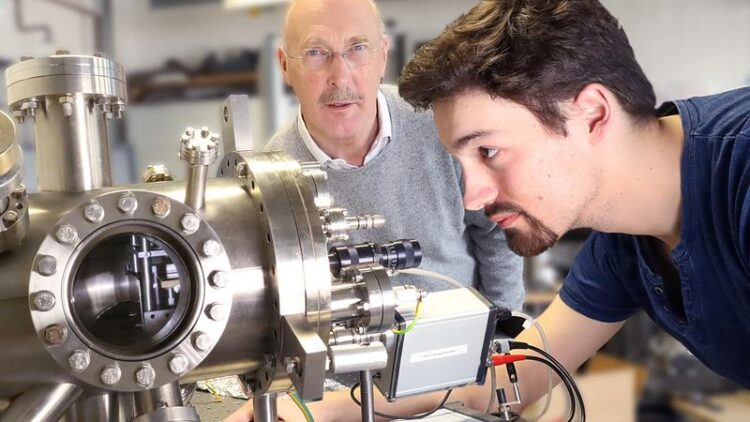New Description of Electrification by Contact: Transfer of Charge Observed

Prof. Rolf Möller und Andre Mölleken am Aufbau.
UDE/Andreas Reichert
Everyone has gotten an electric shock when touching a door handle. That’s because when two different substances touch, an electrostatic charge can occur that dissipates with a small flash. This frictional electricity can be used, for example, to separate particles in exhaust gases, but it can also unintentionally trigger explosions, for example when flammable liquids or powders are being handled. However, what exactly happens during contact electrification is so far only rudimentarily understood.
A team led by experimental physicist Prof. Rolf Möller at the University of Duisburg-Essen (UDE) has succeeded for the first time in observing a transfer of charge during a brief contact; their findings are included in the latest version of the journal Science Advances.*
Every microscopic contact between materials leads to a charge. If there are many contacts, very high electrical voltages of several thousand volts can be generated.
“Although this has been known for a long time, it is still unclear what kind of charged particles these are that are transferred during contact,” says Möller. “They could be single electrons, atoms (ions) or whole molecules consisting of several atoms.”
To get closer to a solution, one would have to analyze exactly the moment when the charge is transferred from one material to the other. This happens breathtakingly fast during contact, namely in a few millionths of a second or even faster.
The process cannot be recorded with conventional equipment. Therefore, Prof. Möller’s research group developed new electronic charge amplifiers that measure very small charges in microseconds. “We dropped a ball with a diameter of 1 millimeter onto a plate from a height of a few centimeters, so that the ball bounced many times. In the process, we measured how the charge changes each time that it comes into contact with the surface,” explains Prof. Möller.
Surprisingly, the team found a higher voltage than expected according to the known calculation model. “This is even found for metals, e.g., a gold sphere on a copper plate,” emphasizes Prof. Möller. “However, exactly this — namely electrification by contact between metals — is considered one of the few clarified processes in the field of frictional electricity. We were able to demonstrate that the transferred charges, although not very large, are sufficient to allow a voltage of 10 volts to occur between the metal ball and the metal plate.”
The speed at which the ball hits the plate must be considered, and this speed was missing from the previous model. “We therefore proposed a new model based on the old one. This incorporates the deformation of the plate and the sphere at contact,” explains Prof. Möller.
* The results are published in the open-access journal Science Advances: https://advances.sciencemag.org/content/7/22/eabg7595
Editor: Ulrike Bohnsack, Tel. +49 203 37 9 2429, ulrike.bohnsack@uni-due.de
Wissenschaftliche Ansprechpartner:
Prof. Dr. Rolf Möller, Experimental Physics, Tel. +49 203 37 9 4220, rolf.moeller@uni-due.de
Originalpublikation:
https://advances.sciencemag.org/content/7/22/eabg7595
DOI: 10.1126/sciadv.abg7595
Weitere Informationen:
Media Contact
All latest news from the category: Power and Electrical Engineering
This topic covers issues related to energy generation, conversion, transportation and consumption and how the industry is addressing the challenge of energy efficiency in general.
innovations-report provides in-depth and informative reports and articles on subjects ranging from wind energy, fuel cell technology, solar energy, geothermal energy, petroleum, gas, nuclear engineering, alternative energy and energy efficiency to fusion, hydrogen and superconductor technologies.
Newest articles

Innovative 3D printed scaffolds offer new hope for bone healing
Researchers at the Institute for Bioengineering of Catalonia have developed novel 3D printed PLA-CaP scaffolds that promote blood vessel formation, ensuring better healing and regeneration of bone tissue. Bone is…

The surprising role of gut infection in Alzheimer’s disease
ASU- and Banner Alzheimer’s Institute-led study implicates link between a common virus and the disease, which travels from the gut to the brain and may be a target for antiviral…

Molecular gardening: New enzymes discovered for protein modification pruning
How deubiquitinases USP53 and USP54 cleave long polyubiquitin chains and how the former is linked to liver disease in children. Deubiquitinases (DUBs) are enzymes used by cells to trim protein…



